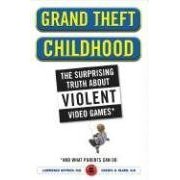I was reluctant in buying that book because some of the content were already known to me and I had access to their published journal articles. So I could’ve saved some money. However, the book contained valuable information that raised eyebrows and some surprising opinions from various experts. The book was well written for a public-oriented audience and had addressed issues parents might have, such as video game violence, addiction, advertisement video games (that was a surprise), etc. I will address some things that I noticed during my reading of this book (as an wanna-be scholar).
As Kutner and Olsen noted, opinions differed based on training, professional background and personal experience (p.63). Throughout the book, they expressed doubts on everything including their own findings. IMO, Besides the persuasive evidence they brought up, another factor I have in mind are the authors’ background, since they’re from a clinical psychological background while other researchers, such as Craig Anderson of Iowa State University are of social psychology background. To elaborate in general, clinical psychologists look for vulnerable groups and what personal and environmental characteristics that may impede these groups’ normal functions within society, in this case whether certain groups are vulnerable to violent video games. This is apparent in their scepticism whether their statistical results apply in real life (see chapter 4). In contrast, social psychologists look for results that apply to individuals of a representative population. So, they may take many factors in consideration and try to see if a variable of interest has an interactional effect with considered factors or an effect beyond such factors. This, I believe, explains why R.L. Huessman’s arguments that violent video games are a public health risk. So, the opinions of experts depend on how they interpret the situation at hand. IMO, Kutner and Olsen seemed to take a pragmatic approach to this problem.
Following this scepticism, I noted in their second chapter on the history of media that they presented many hypocritical figures of anti-media advocates. It makes me wonder if they were selective in choosing their information or this is a true picture of the past. But then again, there’s governor Arnold Schwarzenegger and the various futile legislative acts featured in chapter 8. In addition, they did a good job in showing politicians’ misconceptions of video games and how they created some scandals, such as Hot Coffee, V-tech Rampage, games from interests groups (e.g. KKK) and IMO their tendency to blame something easy in order to have the knowledge they at least accomplished “a good deed”. So I guess the present is not significantly different from the past in terms of some people’s attitudes towards new media. Although, some researchers might argue that past efforts to media legislations were based on anecdotes and personal opinions, but not good scientific evidence (Kirsh, 2003). And so we now have scientific evidence, albeit heavily criticized.
What really raise my eyebrows are the researchers of media violence and what they do. The case of the National Institute of Media and Family (NIMF), I share the same issue as I do with Kutner and Olsen, the name is misleading because they’re not in any way related to the prestigious National Institutes of Health. IMO, The NIMF’s report cards are mostly of an accusatory tone and unacademic-like in their claims, which is kind of ironic since they want children and parents to be more nice to each other, but they might have inadvertently promoted confrontational behaviours between parent and child when video game is the focus of a discussion. Kutner and Olsen added more insult to the injury by showing some good evidence of how deceptive they can be, how they spilled boiling water on cold coffee and how bad their methodology of rating media violence (see chapter 7). Finally, an injury I’d like to give is that I found that one of the staff members has a degree from the University of Phoenix, a university of dubious accreditation.
Among individual researchers, I noticed some points of interests. Most of the names in the book are familiar to me, such as Mark D. Griffiths, Jeffrey Goldstein, Christopher J. Ferguson, which showed Kutner and Olsen did good homework. Parallel to the Byron Report, those that expressed doubt of violent video game research are mostly from European countries whereas those that support it are mostly North Americans. This leads me to think of cultural differences in media violence in addition to differences in scientific research. However, I do believe that there were several cross-cultural studies that found the same conclusion as the North Americans’, but that’s another story. Another eyebrow raising is where a judge was unconvinced of two researchers’ testimony in court whose research is used as support to a legislative bill, where selling any violent video games to minors a criminal offence (p.202). The way the story is told, it made me think that either the researchers were in full support of the bill or were asked to say things to would only support the bill. With this example, this raises the issue of experts’ role in public policy and the danger of participating in a political cause, good or bad.
In comparison to academic-oriented books that I read, it is quite short and sometimes I wanted the authors to elaborate in several parts of the book. Such as providing examples of researchers who use “aggression” and “violence” interchangeably (p.73), relate their findings to the relevant theory (the use and gratification theory), the chapter of why kids play violent video games. There’s probably more, but that’s what stuck to my mind.
Given the cost of buying journal articles to the cost of buying this book, it is quite a bargain. It is even more of a bargain to social students students, as it revealed bits of what really goes in and out of academia, something that is not usually taught to psychology undergraduates.


Jamie Madigan’s review on the book:
http://www.jmadigan.net/2010/07/book_review_grand_theft_childh.html